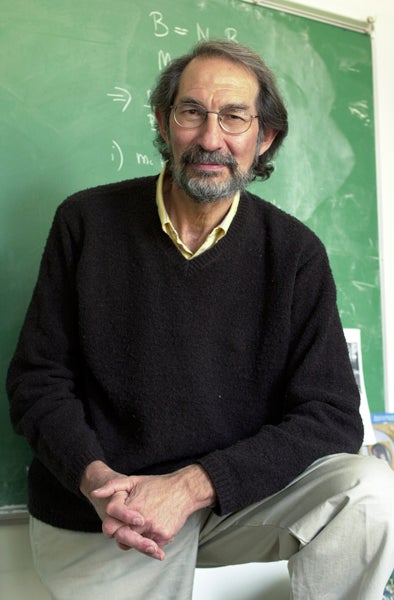 |
April 10, 2012
Physicist Geoffrey West will deliver Stanford's annual Hofstadter Lectures
Cities are the future of the world, with a million people a week becoming urbanized. From cities come the world’s problems, and also their solutions, says physicist Geoffrey West of the Santa Fe Institute. He addresses the problems of urbanization with the formulas of a scientist. By Stephen Tung

Physicist Geoffrey West will give this year’s Robert Hofstadter Memorial Lectures on April 16 and 17. Do biology, aging, cities, sustainability and metabolism have anything in common?
Yes, says theoretical physicist Geoffrey West, a Stanford graduate, former Stanford faculty member and former president of the Santa Fe Institute. He will come back to the Farm April 16 and 17 to answer that question at this year’s Robert Hofstadter Memorial Lectures. The lecture, presented by the Stanford Physics Department, is free and open to the public.
“Physicists appreciate that we can take our training and take it into areas where conventionally, it hasn’t played a major role,” West said in an interview.
West's concept of physics goes beyond the familiar notions of objects flying, light waves bouncing and superfast particles colliding. He searches for underlying mathematical formulas that characterize systems and that can be used to predict the future. West uses his methods of finding formulas to tackle problems in biology and social sciences.
“I come to it with a physics viewpoint, that is connecting things that superficially don’t look like they should be connected,” he said. “Kind of seeing a universality to the ways of thinking about questions about why we sleep, to the nature of the growth of cancer to the [question] why do companies die, to the physics of cities: seeing all of those in the same framework.”
Understanding Cities
For instance, take cities. In a particular country, metrics like the number of patents produced, the amount of gas used and the average wage paid follow a behavior that has more to do with the size of the population than geography, history or culture.
Cities in different countries, like Germany or Japan, follow the same patterns, but the magnitude is different. Violent crime scales up the same way from a small town in Japan to a city like Tokyo in the same fashion that crime scales up from a small town in the United States to New York City, even though the overall magnitude of crime is much greater in the United States.
On average, the big cities seem to obey the same underlying formula, West said. And understanding how cities scale and grow will be important.
“We are urbanizing at an exponential rate. More than half the world is urbanized,” he said. “For the foreseeable future, well over 1 million people a week are being urbanized.”
"The problems that we're all worried about, problems from global warming, the environment, questions of financial markets and risk, questions of health, pollution, and disease, all of these, all are generated within cities,” he said. “They are being exacerbated by these exponential increases in the population of cities worldwide.
Problems, solutions
“On the other hand, if there is a solution to them, it will be generated in cities, because that's where all the smart people are. Cities act as magnets for creativity, ideas, wealth creation and so on. Cities have a dual role: creating the problems and solving the problems.”
“There is an urgency – can there be a serious science of cities?” asked West. “Meaning, can we really understand this phenomenon and be predictive about it? It's the underpinnings of sustainability.”
West’s lecture, “Searching for Simplicity and Unity in the Complexity of Life: Cells to Cities, Companies to Ecosystems, Milliseconds to Millennia,” is scheduled for 8 p.m. on Monday, April 16, at the Hewlett Teaching Center, 370 Serra Mall, Room 200.
He will also be delivering a more technical colloquium titled, “Universal Scaling Laws from Cells to Cities; A Physicist's Search for Quantitative, Unified Theories of Biological and Social Structure and Dynamics,” at 4:15 p.m. on Tuesday, April 17, at the Hewlett Teaching Center, 370 Serra Mall, Room 201. Unlike the Monday talk, which won’t involve any mathematical equations, he said that this colloquium should be understandable to those with an undergraduate level of physics.
The Hofstadter Lectures commemorate the late Nobel Prize-winning physicist Robert Hofstadter, who was a member of the Stanford faculty from 1950 until his death in 1990. When West was a graduate student at Stanford, he once served as a teacher’s assistant for Hofstadter.
-30-
|
 |